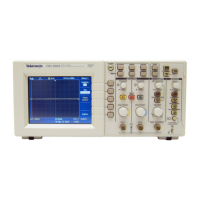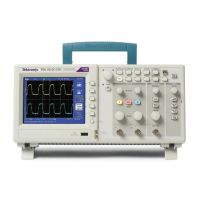Status and Events
3-12
TDS200, TDS1000/2000, TDS1000B/2000B, TPS2000 Programmer
The same command sequence using the *WAI command for
synchronization follows:
/* Set up single-sequence acquisition */
SELECT:CH1 ON
ACQUIRE:MODE SAMPLE
ACQUIRE:STOPAFTER SEQUENCE
/* Acquire waveform data */
ACQUIRE:STATE ON
/* Set up the measurement parameters */
MEASUREMENT:IMMED:TYPE PK2PK
MEASUREMENT:IMMED:SOURCE CH1
/* Wait until the acquisition is complete before taking the
measurement */
*WAI
/* Take peak-to-peak measurement on acquired data */
MEASUREMENT:IMMED:VALUE?
Though *WAI is one of the easiest ways to achieve synchronization,
it is also the most costly. The processing time of the oscilloscope is
slowed, since it is processing a single command at a time. This time
could be spent doing other tasks.
The controller can continue to write commands to the input buffer,
but the commands are not processed by the oscilloscope until all
operations in process are complete. If the input buffer becomes full,
the controller will be unable to write any more commands to the
buffer and will result in a time out.
